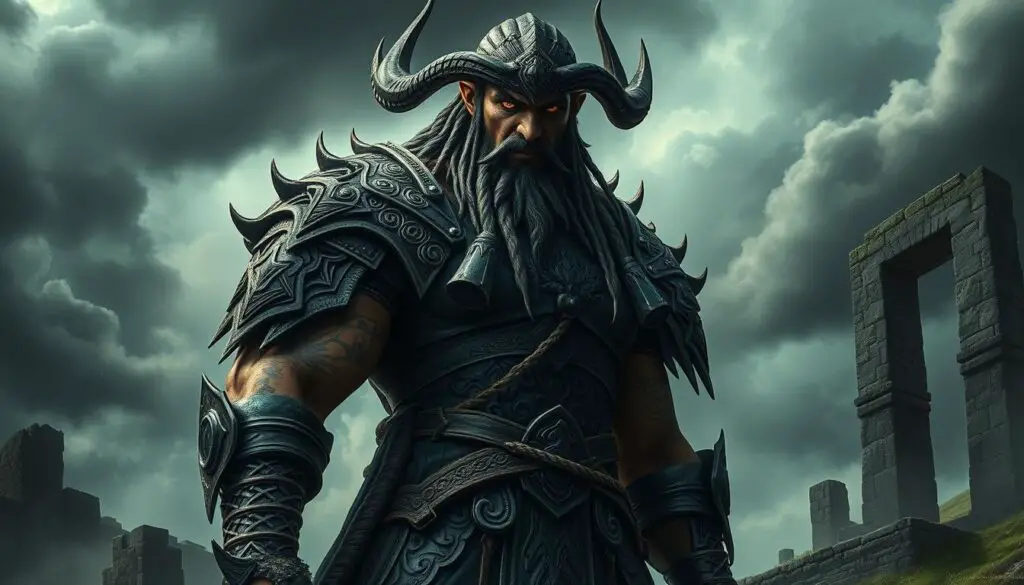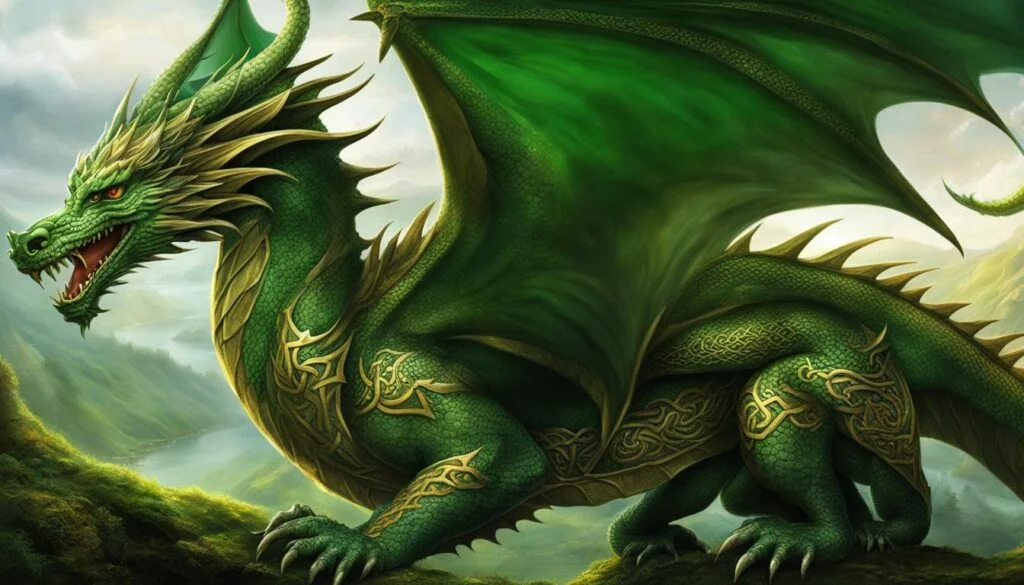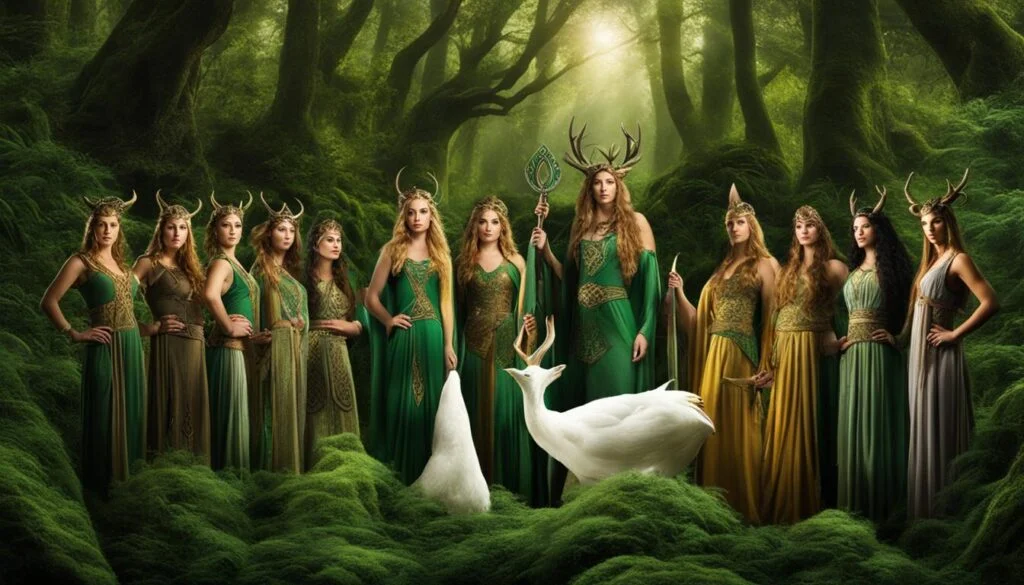Balor is a famous king in Irish myths. He leads the Fomorians, a group of supernatural beings.
He is a giant with one powerful eye. Balor’s legends are filled with stories of his evil deeds.
He used his magic to bring darkness and fear from his home on Tory Island.
Balor plays a big role in many Irish stories, especially in the Battle of Mag Tuired.
He was told he would be killed by his grandson. This came true when Lugh defeated him.
Balor’s death brought changes to Irish myths. His eye, known for destruction, led to the creation of Loch na Súl.
His stories mix evil with the natural world, showing how bad seasons and farming troubles can come.
Key Takeaways
- Balor was a giant with a singular destructive eye in Irish mythology.
- He reigned as the king of the Fomorians, a supernatural race.
- Prophesied to be killed by his grandson, Balor faced his demise at the hands of Lugh.
- The defeat of Balor by Lugh led to the victory of the Tuatha Dé Danann in the Battle of Mag Tuired.
- The sinister powers and dark magic of Balor symbolize agricultural blight and the scorching sun in mythology.
- The impact of Balor’s deadly eye beam created Loch na Súl in County Sligo.
Introduction to Balor and Celtic Mythology
The story of Balor is a key part of Celtic myths and ancient tales. These stories show the rich history of Celtic mythology.
Balor, known as Balor of the Evil Eye, is a scary figure in Irish legends.
When we learn about Balor, we see the big world of Celtic myths. This world is full of gods, heroes, and magical creatures.
They are very important to the Celtic culture.
Overview of Celtic Mythology
Celtic mythology is full of stories that tell us about the Celts’ gods and heroes. The stories are grouped into cycles.
The Mythological Cycle is a key one. It tells about the gods’ origins and adventures.
These tales were first told by mouth and then written down in old books. This helped keep the Celts’ folklore and culture alive.
One famous character is Lugh, Balor’s grandson. Lugh is known for his many skills and bravery.
He plays a big role in Celtic myths. His stories show the complicated relationships and power struggles among the Celtic gods and heroes.
The Importance of Balor in Irish Folklore
Balor is a very important character in Irish stories. He is a well-known demonic figure with a fearsome eye.
He brings destruction in the tales of the Fomorians. Balor is more than just a bad guy.
He shows the constant fight between good and bad, making and breaking.
The story of his big fight with Lugh is a key moment in Irish myths. Balor’s tale is still important today.
It shows up in modern stories and art. This shows how Balor’s story is still part of discussions about ancient Irish culture.
The Fomorians: A Supernatural Race
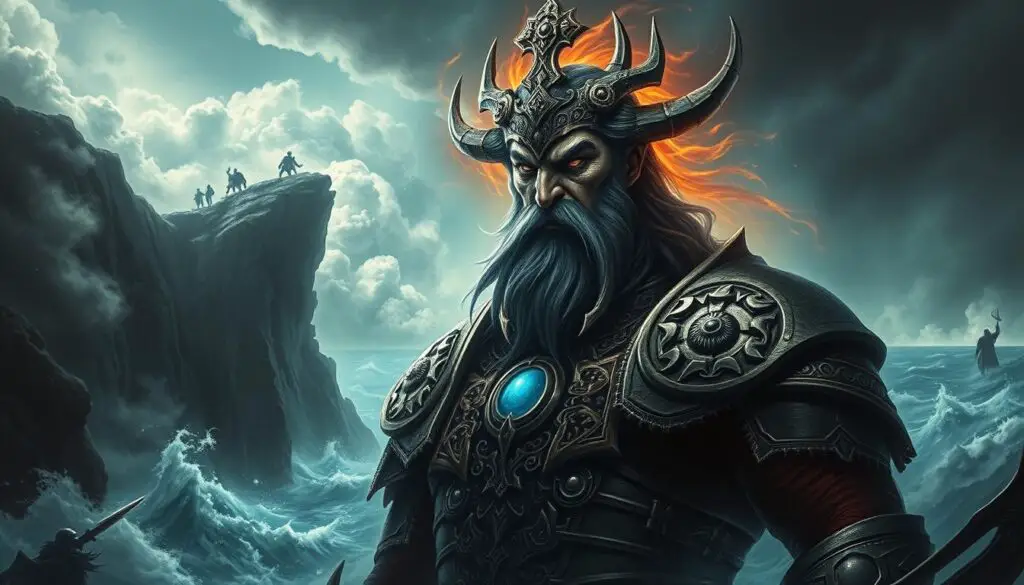
The Fomorians are important in Irish myths. They appear as sea or earth monsters.
They symbolize chaos and destruction.
They fought Ireland’s first inhabitants, the Tuatha Dé Danann. This battle is like others in myths around the world.
The Fomorians loved causing harm and feared nothing.
Origins and Characteristics
They are among the oldest in Irish mythology. They are said to come from the sea.
Their name hints at underwater giants or evil spirits.
Some looked like men with goat heads. Others had one eye, leg, and arm.
These features made them look scary and powerful.
They were strong and used magic based on nature.
The Role of the Fomorians in Irish Mythology
The Fomorians were the main bad guys. They battled the good Tuatha Dé Danann.
They even made the Tuatha Dé Danann serve them for seven years.
Their stories tell of big fights, like the Battles of Mag Tuired. Here they eventually lost to Lugh.
This win showed good beating evil and set a new peace.
The Fomorians’ stories mix with Ireland’s history. They show how people saw nature’s wild side.
These tales are still told today, proving they last.
The Mythological Cycle and Balor’s Role
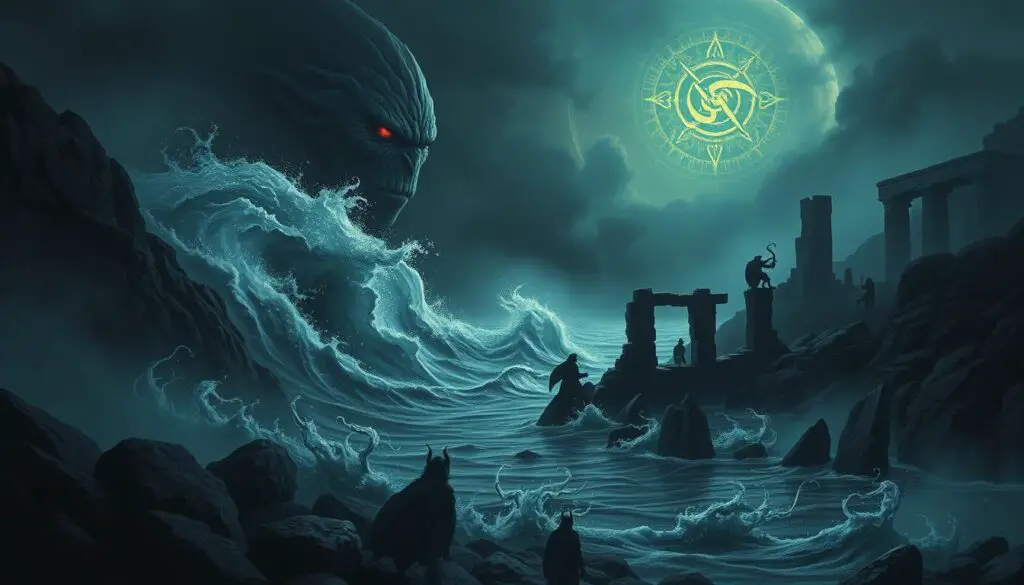
The Mythological Cycle is key in Celtic myths. It tells of gods’ battles and heroes’ journeys.
Characters like the Tuatha Dé Danann and the Fomorians are central. Balor, the Fomorian king, is especially important.
Key Events in the Mythological Cycle
Important events include ancient Irish battles. These formed the main story.
The Tuatha Dé Danann came from heaven. They beat the Fomorians in key battles.
Balor led the Fomorians. His fight with his grandson, Lugh, was crucial.
It was a main part of the story.
- The Second Battle of Mag Tuired: A key battle in the stories. It shows Balor’s deadly eye and his fight with Lugh.
- The Demise of Nuada: Balor killed Nuada, the Tuatha Dé Danann leader. This showed his great strength.
Balor’s Influence and Power
Balor was known for his powerful, destructive eye. He played a big role in the myths.
His weapons were legendary. He was involved in many divine battles.
Even though Lugh defeated him, Balor’s story continues to be told.
- Balor’s Eye: His eye was very destructive. It was similar to the Greek Cyclops. This made him famous in myths.
- Influence on Battles: Balor’s actions led to important characters’ deaths. He had a big impact on the outcomes of battles.
Balor’s part in the Mythological Cycle is vital. His influence and strength shaped the epic Irish tales.
The Battle of Mag Tuired
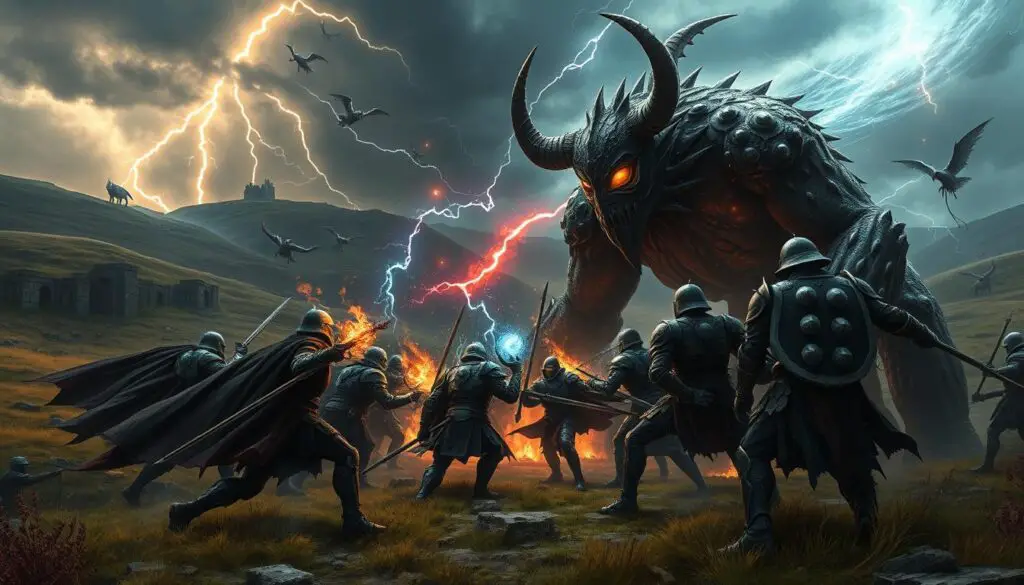
The Battle of Mag Tuired is a key event in Irish legends. This legendary conflict was between the Tuatha Dé Danann and the Fomorians, led by Balor.
It is famous for its detailed fight stories and epic battle.
Description of the Battle
The Tuatha Dé Danann came to Ireland in 300 ships, facing the Fir Bolg.
They fought hard for four days at Balgatan’s Pass. Nuada, the king, lost his right hand in battle.
A truce was made, and the Fir Bolg had to choose: leave, share the land, or keep fighting.
Sreng chose to fight but took one province of Ireland later.
The Second Battle of Mag Tuired was even more fierce.
Bres, with the Fomorians, wanted his kingship back. A huge battle followed with the Tuatha Dé Danann warriors facing the Fomorians.
Balor’s Role and Defeat
Balor was crucial in the battle. His deadly eye threatened the Tuatha Dé Danann.
But, his grandson Lugh turned the tide. With a precise sling shot, Lugh defeated Balor. This victory was big for the Tuatha Dé Danann.
The battle of Mag Tuired is a major part of Irish myth. It shows divine beings battling it out.
The victory stands as a strong story from the Irish heroic age. It highlights the fight between good and evil in myths.
Balor’s Fearsome Eye
Balor was known for being scary. His eye was a big symbol of fear. He was the king of the Fomorians.
His gaze could kill or destroy anything it looked at. People said his eye glowed red.
It had a curse that made it very powerful in myths.
The Deadly Power of Balor’s Eye
Many stories tell of Balor’s deadly gaze. His eyelid was so heavy it took many warriors to lift.
This showed how strong he was. His eye could turn people into stone or kill plants.
During a big battle, his eye caused a lot of deaths.
Legends Surrounding Balor’s Eye
There are many stories about Balor. Some say a curse from birth gave his eye power.
Others say he got his powers in other ways. One story tells how his grandson, Lugh, defeated him by hitting the eye with a spear.
After Balor died, they kept his eye in crystal. This adds to his story and the tales of ancient battles.
Balor in Folktale and Legend

Balor’s story is a big part of Ireland’s storytelling tradition. He was a mean ruler who wanted to avoid a prophesied doom.
A prophecy warned Balor he would be killed by his grandson. To stop this, he locked away his daughter.
He hoped this would stop her from having a child. But destiny had other plans. Lugh, a hero in local lore and Irish folktale, changed everything.
Balor’s Prophecy and Attempts to Avert It
Balor tried hard to escape the prophecy. He isolated his daughter with strict measures.
Yet, the prophecy came true thanks to Lugh. This story is key in Irish mythical lineage. It shows that you can’t avoid destiny.
It also shows that trying to prevent it with supernatural intervention doesn’t work.
Variations of Balor’s Folktale
There are many versions of Balor’s story. Some focus on the weapons used against him.
Tools like fiery rods and slingshots show the creativity of Celtic myths. Each tale adds to Balor’s character.
He’s depicted as a giant, twelve feet tall, with a huge eye and strong limbs. These stories make Irish folklore even more fascinating.
Balor’s Connection to Other Mythologies
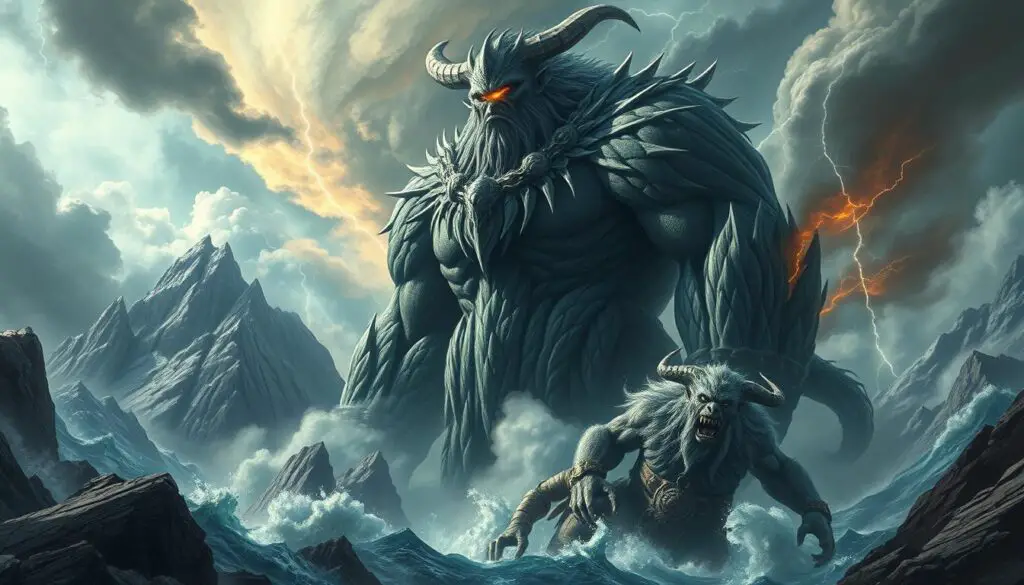
Balor is a key figure in Celtic myths. He reminds us of similar beings in other cultures, especially in Europe.
His traits match with classic monsters and legendary titans found worldwide.
Comparisons with the Greek Cyclops
Balor is often compared to the Greek Cyclops. Both are one-eyed giants with great strength.
Like Polyphemus from Greek tales, they are powerful and big. Their single eyes let them unleash destruction, showing how myths overlap.
Similarities to Welsh Ysbaddaden
Balor’s stories also connect to Welsh folklore, with the giant Ysbaddaden.
They are both huge and have important eyes. In Welsh tales, Ysbaddaden’s eye is powerful, much like Balor’s.
These stories from Europe share common themes, linking different folklores.
Balor’s Death and Its Significance
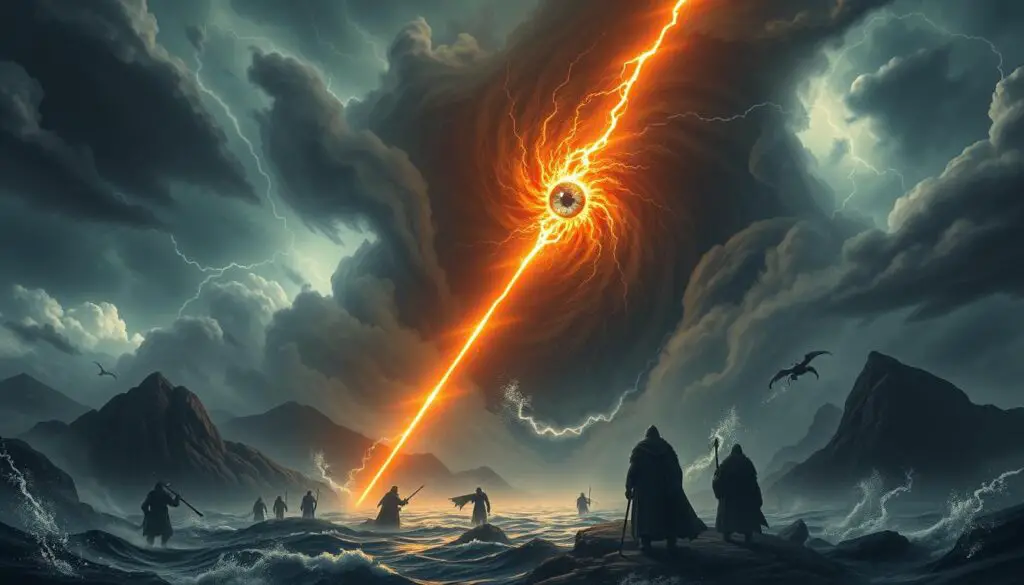
Balor’s death in Irish mythology is full of deep meanings. He was the evil Fomorian king.
His death is told in different ways, making it important in folklore.
Different Accounts of Balor’s Death
Stories about how Balor died are diverse. In one tale, during the epic fight of Mag Tuired, Lugh defeats Balor.
He does this by hitting Balor’s deadly eye with a stone. This act fulfills a prophecy and brings victory to the Tuatha Dé Danann.
Another story tells of Lugh chasing Balor and then beheading him.
This shows Lugh’s unyielding drive to win. It adds drama to the fight, too.
The Symbolism Behind His Death
Balor’s death means more than just a fight between good and bad. It deals with light fighting darkness.
It’s often seen as a battle like those against the sun’s dangers. These stories show how lasting and flexible Celtic tales are.
They keep being told and written down.
Balor’s Eye and Other Mythical Weapons
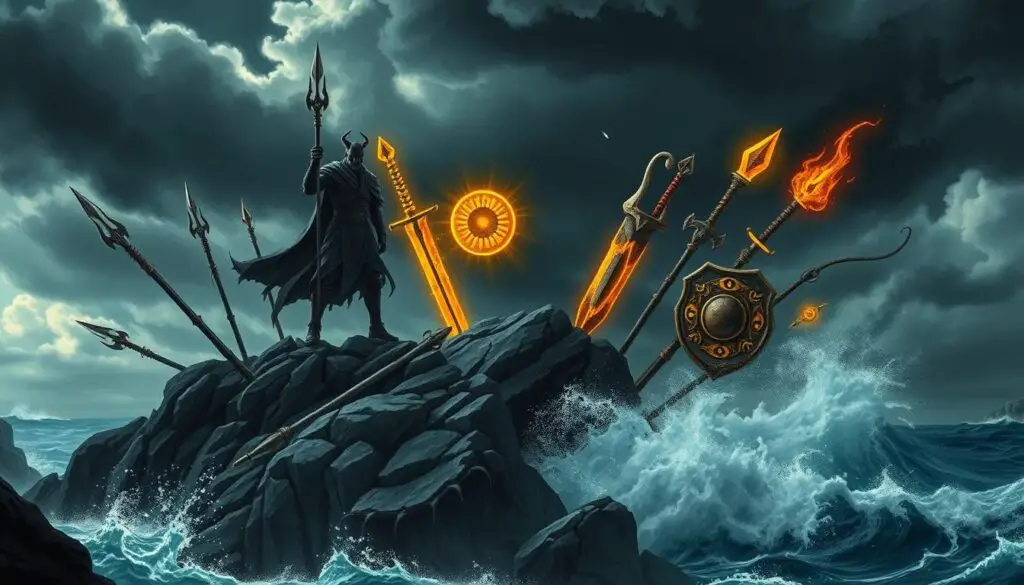
Balor’s Eye is a famous, scary weapon in myths. It’s one of many legendary weapons with great power.
These weapons have interesting stories in old myths.
Balor’s Eye could destroy armies with just one look. It was super powerful and showed Balor’s strength.
This eye was feared in battle.
Other Celtic myth weapons have magic too. Lorg Mór, or the Staff of Wrath, needed eight men to carry it.
It could take out nine enemies at once. The spear Gae Bulg would leave barbs inside its target, making it deadly.
The Claiomh Solais, the Sword of Light, made its holder unstoppable. Unworthy people couldn’t even pull it out without causing a racket.
It’s just as important as Balor’s Eye in myths.
Another special spear, Luin of Celtchar, needed blood to calm down. It could kill nine men, often aiming at kings.
Weapons like this added excitement to Celtic myths.
Weapons like Fragarach, the Answerer, and Moralltach, the Great Fury, are also cool.
They made their users stronger and changed battles. These stories are full of magic.
So, Celtic myths have many amazing weapons, not just Balor’s Eye. They are symbols of magic and power.
They keep the old stories alive and interesting.
Interpretations of Balor’s Character
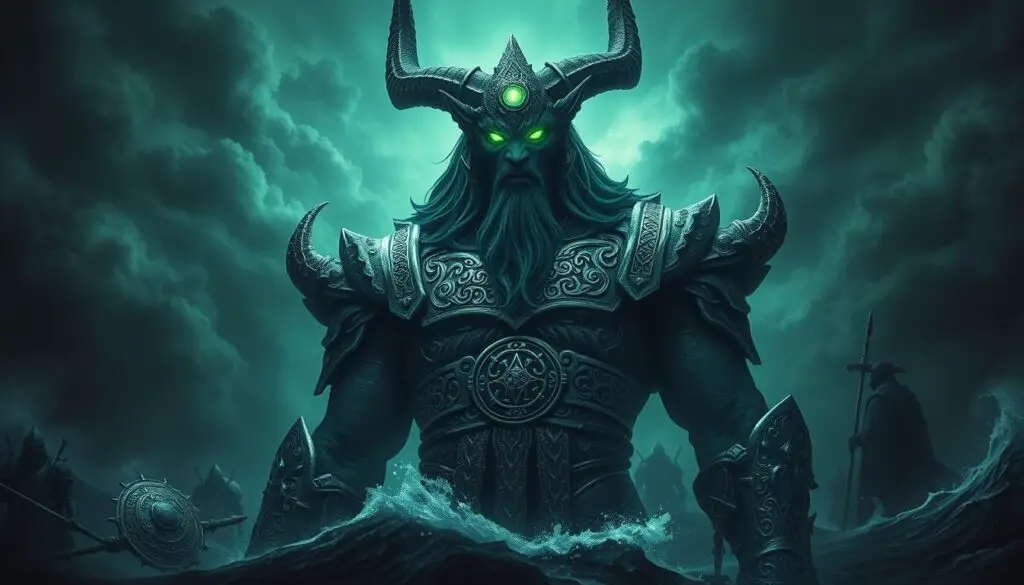
Balor is an ancient god from Irish myths. He was a fearsome leader with a deadly eye.
He shows the chaos and destruction of the Fomorians.
Balor as a Personification of the Scorching Sun
Balor is seen as the scorching sun by some. His evil eye represents the sun’s harmful power.
This idea fits with the Fomorians’ link to tough natural elements.
The eye’s power in battle shows it as a key symbol of destruction.
Modern Understandings of Balor’s Myth
Today, experts mix old stories with new ideas to understand Balor’s role.
They think about what Balor means in folklore and larger themes. One example is the battle between order and chaos.
Also, Balor’s story is still told in modern times. For example, wrestler Finn Bálor uses ‘The Demon’ persona.
It brings Balor’s old story into today’s world. This shows how Balor’s story is still shared and changed over time.
The Legacy of Balor in Modern Culture
Balor’s impact is huge in today’s culture. It goes way beyond old myths to today’s stories and media.
You can see his influence in lots of books and shows. They keep using his myth for new works.
Balor in Literature and Media
Balor’s scary look and story are in many fantasy tales. His story is retold in books and comics.
This shows Balor’s lasting charm. He fits well in both old tales and new digital stories.
In movies, shows, and games, Balor’s evil eye is a key symbol. These show him as a strong bad guy.
It makes him a famous villain in fantasy stories.
Balor’s Influence on Modern Fantasy
Balor’s tale is key in modern fantasy. His myth is part of many new stories. T
hemes like prophecy and power connect with readers.
Writers use Balor’s story to make new worlds and characters.
These stories keep Balor’s myth alive for all. Stories by J.R.R. Tolkien and Neil Gaiman show Balor’s lasting impact.
His myth keeps adding to our fantasy worlds.
Conclusion
The story of Balor comes from old tales and myths. It shows us the rich culture and stories of the Celts. Balor’s adventures involve battles, magic, and fate.
They also show how beliefs changed over time. His powerful eye and the big fight at Mag Tuired keep us interested.
These myths about Balor remind us how important old tales are. They help us understand the past thoughts of people.
Seeing Balor in books and movies today shows he’s still important. It proves we love revisiting these mythic tales and characters.
Balor’s tale goes beyond the past. It connects with the stories humans have always told. His story is not just exciting but important today too. A
s we find new ways to tell his story, Balor remains a key myth. His legend keeps influencing our stories, now and in the future.
Frequently Asked Questions
Q: What did Balor do?
Balor, a figure from Irish mythology, is famously known for his destructive eye that wrought havoc in battles. He was a leader of the Fomorians, a group of demonic beings, and played a pivotal role in the mythical battles against the Tuatha Dé Danann.
Q: Who is Balor’s wife in mythology?
Balor’s wife is not widely noted in the main myths where he appears; thus, her identity is generally not specified in the traditional stories.
Q: Where was Balor killed?
Balor was killed at the Second Battle of Mag Tuired, a legendary confrontation detailed in Irish mythology. He was slain by his grandson Lugh, who shot a stone through Balor’s evil eye.
Q: Is Balor a demon or devil?
In mythology, Balor is often considered a demonic figure due to his malevolent characteristics and leadership among the Fomorians, who are likened to demons or dark deities.
Q: What is Balor the god of?
Balor is not traditionally worshipped as a god; instead, he is known as a king of the Fomorians. His association with drought and blight in folklore sometimes positions him as a godlike figure of destruction.
Q: What happens when a Balor dies?
When Balor was killed, according to mythology, the power of his destructive eye was turned back upon the Fomorian army, leading to their defeat at the hands of the Tuatha Dé Danann.
Q: How powerful is Balor?
Balor is depicted as one of the most powerful beings in Irish mythology, with his deadly eye that could slay armies and his command over the fearsome Fomorians.


